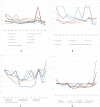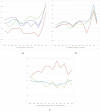Regional differences and dynamic evolution of agricultural water resources utilization efficiency in China
- PMID: 37768897
- PMCID: PMC10538784
- DOI: 10.1371/journal.pone.0282051
Regional differences and dynamic evolution of agricultural water resources utilization efficiency in China
Abstract
Improving water resources utilization efficiency is conducive to achieving the sustainable development of water resources. It is essential to explore the regional differences and dynamic evolution of agricultural water resources utilization efficiency in China to promote high-quality development of agriculture. In this study, based on the unexpected output, we build a super slack-based measure model to measure agricultural water resources utilization efficiency in China's provinces from 2007 to 2018. In addition, we use the Dagum Gini coefficient to analyze the source of regional differences. Finally, we construct the distributed dynamics model to explore the distribution of the dynamic evolution trend of China's agricultural water resources utilization efficiency. The results reveal that regional difference is the main source of the overall difference in agricultural water resources utilization efficiency in China. Spatial imbalance exists in the development of agricultural water resources utilization efficiency in China. The agricultural water resources utilization efficiency in various provinces and regions of China is relatively stable, having the characteristics of club convergence. The probability of maintaining the initial state is high, and the internal mobility is low. However, with time, the degree of club convergence decreases.
Copyright: © 2023 Zeng et al. This is an open access article distributed under the terms of the Creative Commons Attribution License, which permits unrestricted use, distribution, and reproduction in any medium, provided the original author and source are credited.
Conflict of interest statement
The authors declare no conflict of interest.
Figures




References
-
- Qu Wei, et al. “Agricultural Water Use Efficiency—A Case Study of Inland-River Basins in Northwest China.”. Sustainability 12.23 (2020): 10192. doi: 10.3390/su122310192 - DOI
-
- Deng XiPing, et al. “Improving agricultural water use efficiency in arid and semiarid areas of China.”. Agricultural water management 80.1-3 (2006): 23–40. doi: 10.1016/j.agwat.2005.07.021 - DOI
-
- Wang Haoying. “Irrigation efficiency and water withdrawal in US agriculture.”. Water Policy 21.4 (2019): 768–786. doi: 10.2166/wp.2019.175 - DOI
-
- Nazari Bijan, et al. “Irrigation water management in Iran: Implications for water use efficiency improvement.”. Agricultural water management 208 (2018): 7–18. doi: 10.1016/j.agwat.2018.06.003 - DOI
Publication types
MeSH terms
LinkOut - more resources
Full Text Sources

